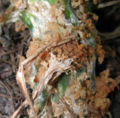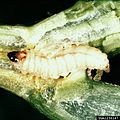- Squash vine borer
-
Squash Vine Borer 
Scientific classification Kingdom: Animalia Phylum: Arthropoda Class: Insecta Order: Lepidoptera Family: Sesiidae Genus: Melittia Species: M. cucurbitae Binomial name Melittia cucurbitae
(Harris, 1828)[1]Synonyms - Aegeria cucurbitae Harris, 1828
- Melittia satyriniformis (Hübner, [1827-1831])
- Trochilium ceto (Westwood, 1848)
- Melittia amoena (Edwards, 1882)
The squash vine borer (Melittia cucurbitae) is a diurnal species of sesiid moth that attacks wild and cultivated varieties of squash. The moth is often mistaken for a bee or wasp because of its movements, and the bright orange hindleg scales. The females typically lay their eggs at the base of leaf stalks, and the caterpillars develop and feed inside the stalk, eventually killing the leaf. They soon migrate to the main stem, and with enough feeding damage to the stem, the entire plant may die.
Contents
Habitat
The squash vine borer lives in most temperate North American states, except the Pacific coast. Southern states have two broods a year of the borer.
Control
Pesticides are ineffective after the larvae are inside the plant. Gardeners find this a difficult pest to combat. Some try to avoid the pest by timing the production season to harvest before the pests can build up, or after they have peaked.
Prevention includes pesticides to kill the adult moth (such use must not contaminate the flowers, as pollinators would be killed by poisoned nectar or pollen). Organic controls include wrapping the lower stem with nylon stockings or aluminum foil to prevent egg laying, which generally occurs within a couple inches from the point where the stem emerges from the soil. Row covers can be used up until bloom. An old gardener trick for vining squash and pumpkin cultivars is to cover the vine with earth at various points along its length, inducing rooting at several points, thereby continuing to feed the developing fruit despite the loss of the original stem. It may be noted that after the vine has taken root at multiple points, the infected portion of the plant can be cut off, along with another inch where the larvae is eating into healthy tissue, without significant damage to the plant.
Once larvae are present within the stems control must be quick. Often the first noticed sign of the problem is wilting of the vine, and it is too late for control efforts at that point. Experienced gardeners watch the stems for signs of frass protruding from small holes, which is a giveaway to the presence of the larva inside. Some gardeners carefully cut the stem along its axis and remove the caterpillar before it does too much damage. Others use a stiff wire, a needle, or a toothpick to kill the borer without too much damage.
Gallery
References
Categories:- Sesiidae
- Agricultural pest insects
Wikimedia Foundation. 2010.





